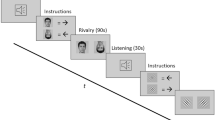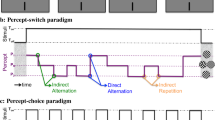Abstract
Rationale
Binocular rivalry occurs when different images are simultaneously presented to each eye. During continual viewing of this stimulus, the observer will experience repeated switches between visual awareness of the two images. Previous studies have suggested that a slow rate of perceptual switching may be associated with clinical and drug-induced psychosis.
Objectives
The objective of the study was to explore the proposed relationship between binocular rivalry switch rate and subjective changes in psychological state associated with 5-HT2A receptor activation.
Materials and methods
This study used psilocybin, the hallucinogen found naturally in Psilocybe mushrooms that had previously been found to induce psychosis-like symptoms via the 5-HT2A receptor. The effects of psilocybin (215 μg/kg) were considered alone and after pretreatment with the selective 5-HT2A antagonist ketanserin (50 mg) in ten healthy human subjects.
Results
Psilocybin significantly reduced the rate of binocular rivalry switching and increased the proportion of transitional/mixed percept experience. Pretreatment with ketanserin blocked the majority of psilocybin’s “positive” psychosis-like hallucinogenic symptoms. However, ketanserin had no influence on either the psilocybin-induced slowing of binocular rivalry or the drug’s “negative-type symptoms” associated with reduced arousal and vigilance.
Conclusions
Together, these findings link changes in binocular rivalry switching rate to subjective levels of arousal and attention. In addition, it suggests that psilocybin’s effect on binocular rivalry is unlikely to be mediated by the 5-HT2A receptor.



Similar content being viewed by others
References
Aghajanian GK, Hailgler HJ (1975) Hallucinogenic indoleamines: preferential action upon presynaptic serotonin receptors. Psychopharmacol Commun 1:619–629
Aghajanian GK, Marek GJ (1997) Serotonin induces excitatory postsynaptic potentials in apical dendrites of neocortical pyramidal cells. Neuropharmacology 36:589–599
Beique JC, Imad M, Mladenovic L, Gingrich JA, Andrade R (2007) Mechanism of the 5-hydroxytryptamine 2A receptor-mediated facilitation of synaptic activity in prefrontal cortex. Proc Natl Acad Sci U S A 104:9870–9875
Blair JB, Kurrasch-Orbaugh D, Marona-Lewicka D, Cumbay MG, Watts VJ, Barker EL, Nichols DE (2000) Effect of ring fluorination on the pharmacology of hallucinogenic tryptamines. J Med Chem 43:4701–4710
Blake R, Logothetis NK (2002) Visual competition. Nat Rev Neurosci 3:13–21
Brainard DH (1997) The psychophysics toolbox. Spat Vis 10:433–436
Carter OL, Pettigrew JD (2003) A common oscillator for perceptual rivalries? Perception 32:295–305
Carter OL, Pettigrew JD, Burr DC, Alais D, Hasler F, Vollenweider FX (2004) Psilocybin impairs high-level but not low-level motion perception. Neuroreport 15:1947–1951
Carter OL, Burr DC, Pettigrew JD, Wallis GM, Hasler F, Vollenweider FX (2005a) Using psilocybin to investigate the relationship between attention, working memory and the Serotonin1A&2A receptors. J Cog Neuroscience 17:1497–1508
Carter OL, Pettigrew JD, Hasler F, Wallis GM, Liu GB, Hell D, Vollenweider FX (2005b) Modulating the rate and rhythmicity of perceptual rivalry alternations with the mixed 5-HT2A and 5-HT1A agonist psilocybin. Neuropsychopharmacology 30:1154–1162
Carter OL, Presti DE, Callistemon C, Ungerer Y, Liu GB, Pettigrew JD (2005c) Meditation alters perceptual rivalry in Tibetan Buddhist monks. Curr Biol 15:R412–R413
Chong S, Tadin D, Blake R (2005) Endogenous attention prolongs dominance durations in binocular rivalry. J Vis 5:1004–1012
Cimmer C, Szendi I, Csifcsak G, Szekers G, Ambrus Kovacs Z, Somogyi I, Benedek G, Janka Z, Keri S (2006) Abnormal neurological signs, visual contrast sensitivity and the deficit syndrome of schizophrenia. Prog Neuropsychopharmacol Biol Psychiatry 30:1225–1230
Dahlstrom A, Fuxe K (1964) Evidence for the existence of monoamine-containing neurons in the central nervous system. I. Demonstration of monoamines in the cell bodies of brain stem neurons. Acta Physiol Scand 62:5–55
Dittrich A (1998) The standardized psychometric assessment of altered states of consciousness (ASCs) in humans. Pharmacopsychiatry 31(2):80–84
Foote SL, Bloom FE, Aston-Jones G (1983) Nucleus locus ceruleus: new evidence of anatomical and physiological specificity. Physiol Rev 63:844–914
Frecska E, White KD, Luna LE (2004) Effects of ayahuasca on binocular rivalry with dichoptic stimulus alternation. Psychopharmacolgy 173:79–87
Gonzalez-Maeso J, Weisstaub NV, Zhou M, Chan P, Ivic L, Ang R, Lira A, Bradley-Moore M, Ge Y, Zhou Q, Sealfon SC, Gingrich JA (2007) Hallucinogens recruit specific cortical 5-HT(2A) receptor-mediated signaling pathways to affect behavior. Neuron 53:439–452
Gouzoulis-Mayfrank E, Hermle L, Thelen B, Sass H (1998) History, rationale and potential of human experimental hallucinogenic drug research in psychiatry. Pharmacopsychiatry 31(2):63–68
Gouzoulis-Mayfrank E, Heekeren K, Neukirch A, Stoll M, Stock C, Obradovic M, Kovar KA (2005) Psychological effects of (S)-ketamine and N,N-dimethyltryptamine (DMT): a double-blind, cross-over study in healthy volunteers. Pharmacopsychiatry 38:301–311
Griffiths RR, Richards WA, McCann U, Jesse R (2006) Psilocybin can occasion mystical-type experiences having substantial and sustained personal meaning and spiritual significance. Psychopharmacology (Berl) 187:268–283; discussion 284–92
Hamon M, Gozlan H, El Mestikawy S, Emerit MB, Bolanos F, Schechter L (1990) The central 5-HT1A receptors: Pharmacological, biochemical, functional, and regulatory properties. Ann N Y Acad Sci 600:114–129
Hasler F, Bourquin D, Brenneisen R, Bar T, Vollenweider FX (1997) Determination of psilocin and 4-hydroxyindole-3-acetic acid in plasma by HPLC-ECD and pharmacokinetic profiles of oral and intravenous psilocybin in man. Pharm Acta Helv 72:175–184
Hasler F, Grimberg U, Benz MA, Huber T, Vollenweider FX (2004) Acute psychological and physiological effects of psilocybin in healthy humans: a double-blind, placebo-controlled dose-effect study. Psychopharmacology 172:145–156
Jacobs BL, Azmitia EC (1992) Structure and function of the brain serotonin system. Physiol Rev 72:165–229
Jakab RL, Goldman-Rakic PS (1998) 5-Hydroxytryptamine2A serotonin receptors in the primate cerebral cortex: possible site of action of hallucinogenic and antipsychotic drugs in pyramidal cell apical dendrites. Proc Natl Acad Sci U S A 95:735–740
Janke W, Debus G (1978) Die Eigenshaftswörterliste EWL. Handanweisung, Handanweisung
Krebs-Thomson K, Ruiz EM, Masten V, Mahalah B, Geyer M (2006) The roles of 5-HT1A and 5-HT2 receptors in the effects of 5-MeO-DMT on locomotor activity and prepulse inhibition in rats. Psychopharmacology 189:319–329
Lambe EK, Aghajanian GK (2007) Prefrontal cortical network activity: opposite effects of psychedelic hallucinogens and D1/D5 dopamine receptor activation. Neuroscience 145:900–910
Lee SH, Blake R, Heeger DJ (2005) Traveling waves of activity in primary visual cortex during binocular rivalry. Nat Neurosci 8:22–23
Leonard CM, White KD, Marone L, Riccuiti N, Pettigrew JD, Kuldau JM (2001) Perceptual alternation, anatomy and cognition in schizophrenia. Society for Neuroscience Abstract No. 954.19
Leopold DA, Logothetis NK (1996) Activity changes in early visual cortex reflect monkeys’ percepts during binocular rivalry. Nature 379:549–553
Lumer ED, Friston KJ, Rees G (1998) Neural correlates of perceptual rivalry in the human brain. Science 280:1930–1934
McKenna DJ, Repke DB, Lo L, Peroutka SJ (1990) Differential interactions of indolealkylamines with 5-hydroxytryptamine receptor subtypes. Neuropharmacology 29:193–198
Miller SM, Gynther BD, Heslop KR, Liu GB, Mitchell PB, Ngo TT, Pettigrew JD, Geffen LB (2003) Slow binocular rivalry in bipolar disorder. Psychol Med 33:683–692
Mitchell J, Stoner G, Reynolds J (2004) Object-based attention determines dominance in binocular rivalry. Nature 429:410–413
Nichols DE (2004) Hallucinogens. Pharmacol Ther 101:131–181
Paffen C, D. A, Verstraten F (2006) Attention speeds binocular rivalry. Psychol Sci 17:752–756
Pazos A, Palacios JM (1985) Quantitative autoradiographic mapping of serotonin receptors in the rat brain. I. Serotonin-1 receptors. Brain Res 346:205–230
Perrson B, Heykants J, Hedner T (1991) Clinical pharmacokinetics of ketanserin. Clin Pharmacokinet 20:263–279
Pettigrew JD (2001) Searching for the switch: neural bases for perceptual rivalry alternations. Brain and Mind 2:85–118
Pettigrew JD, Miller SM (1998) A ‘sticky’ interhemispheric switch in bipolar disorder? Proc R Soc Lond B Biol Sci 265:2141–2148
Richelson E, Souder T (2000) Binding of antipsychotic drugs to human brain receptors: focus on newer generation compounds. Life Sci 68:29–39
Sheinberg DL, Logothetis NK (1997) The role of temporal cortical areas in perceptual organization. Proc Natl Acad Sci U S A 94:3408–3413
Slaghuis WL (2004) Spatio-temporal luminance contrast sensitivity and visual backward masking in schizophrenia. Exp Brain Res 156:196–211
Sotelo C, Cholley B, El Mestikawy S, Gozlan H, Hamon M (1990) Direct immunohistochemical evidence of the existence of 5-HT1A autoreceptors on serotoninergic neurons in the midbrain raphe nuclei. Eur J Neurosci 2:1144–1154
Sprouse JS, Aghajanian GK (1986) (−)-Propranolol blocks the inhibition of serotonergic dorsal raphe cell firing by 5-HT1A selective agonists. Eur J Pharmacol 128:295–298
Tong F, Engel SA (2001) Interocular rivalry revealed in the human cortical blind-spot representation. Nature 411:195–199
Tong F, Meng M, Blake R (2006) Neural bases of binocular rivalry. Trends Cogn Sci 10:502–511
Umbricht D, Vollenweider FX, Schmid L, Grubel C, Skrabo A, Huber T, Koller R (2003) Effects of the 5-HT2A agonist psilocybin on mismatch negativity generation and AX-continuous performance task: implications for the neuropharmacology of cognitive deficits in schizophrenia. Neuropsychopharmacology 28:170–181
Vollenweider FX, Geyer MA (2001) A systems model of altered consciousness: integrating natural and drug-induced psychoses. Brain Res Bull 56:495–507
Vollenweider FX, Leenders KL, Scharfetter C, Maguire P, Stadelmann O, Angst J (1997) Positron emission tomography and fluorodeoxyglucose studies of metabolic hyperfrontality and psychopathology in the psilocybin model of psychosis. Neuropsychopharmacology 16:357–372
Vollenweider FX, Vollenweider-Scherpenhuyzen MF, Babler A, Vogel H, Hell D (1998) Psilocybin induces schizophrenia-like psychosis in humans via a serotonin-2 agonist action. Neuroreport 9:3897–3902
Vollenweider FX, Csomor PA, Knappe B, Geyer MA, Quednow BB (2007) The effects of the preferential 5-HT2A agonist psilocybin on prepulse inhibition of startle in healthy human volunteers depend on interstimulus interval. Neuropsychopharmacology 32:1876–1887
Weisstaub NV, Zhou M, Lira A, Lambe E, Gonzalez-Maeso J, Hornung JP, Sibille E, Underwood M, Itohara S, Dauer WT, Ansorge MS, Morelli E, Mann JJ, Toth M, Aghajanian G, Sealfon SC, Hen R, Gingrich JA (2006) Cortical 5-HT2A receptor signaling modulates anxiety-like behaviors in mice. Science 313:536–540
Wheatstone C (1838) On some remarkable, and hitherto unobserved, phenomena of binocular vision. Philos Trans R Soc Lond 128:371–394
Wilson H (2004) Rivalry and perceptual oscillations: a dynamical synthesis. In: Alais D, Blake R (eds) Binocular rivalry. MIT Press, Cambridge
Wilson HR, Blake R, Lee SH (2001) Dynamics of travelling waves in visual perception. Nature 412:907–910
Wittmann M, Carter O, Hasler F, Cahn BR, Grimberg U, Spring P, Hell D, Flohr H, Vollenweider FX (2007) Effects of psilocybin on time perception and temporal control of behaviour in humans. J Psychopharmacol 21:50–64
Wong DF, Lever JR, Hartig PR, Dannals RF, Villemagne V, Hoffman BJ, Wilson AA, Ravert HT, Links JM, Scheffel U et al (1987) Localization of serotonin 5-HT2 receptors in living human brain by positron emission tomography using N1-([11C]-methyl)-2-Br-LSD. Synapse 1:393–398
Acknowledgments
The authors would like to thank David Nichols for critical comments on the manuscript. This investigation was financially supported by the Heffter Research Institute, Santa Fe, New Mexico, USA, a National Alliance for Research on Schizophrenia and Depression (NARSAD) grant to F. Hasler, and a Stanley Foundation grant to J. D. Pettigrew.
Author information
Authors and Affiliations
Corresponding author
Rights and permissions
About this article
Cite this article
Carter, O.L., Hasler, F., Pettigrew, J.D. et al. Psilocybin links binocular rivalry switch rate to attention and subjective arousal levels in humans. Psychopharmacology 195, 415–424 (2007). https://doi.org/10.1007/s00213-007-0930-9
Received:
Accepted:
Published:
Issue Date:
DOI: https://doi.org/10.1007/s00213-007-0930-9




